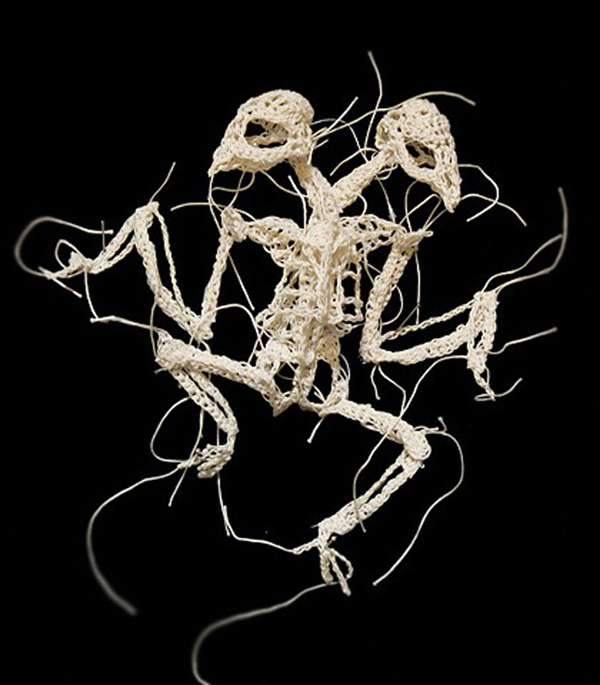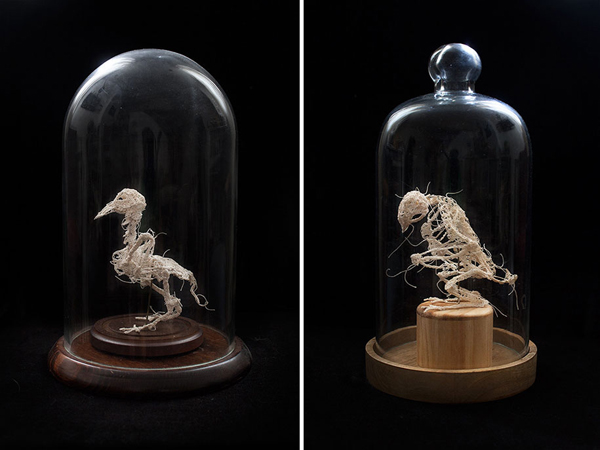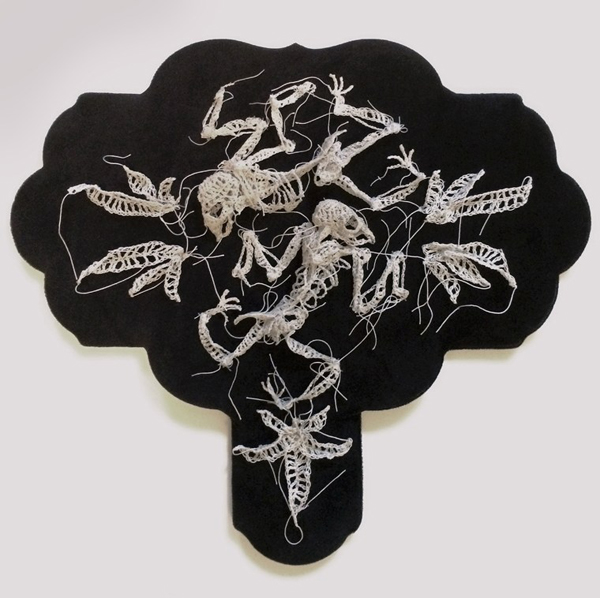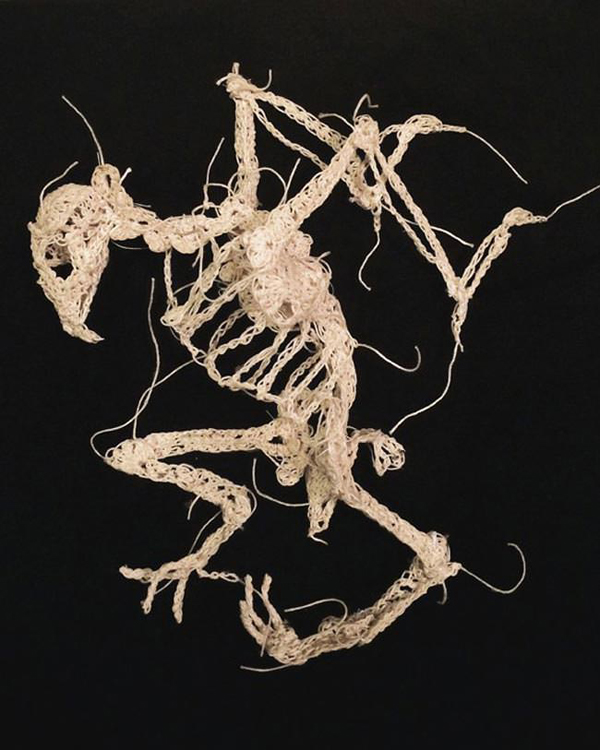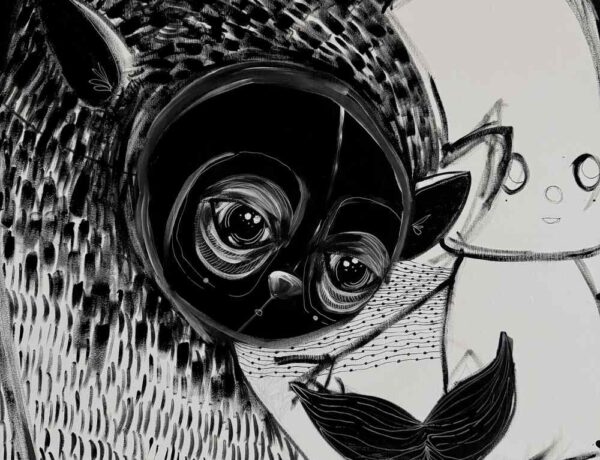Stemming from an obsessive imagination as child, envisioning her grandmother’s doilies unraveling and magically creating new beings in place of their crocheted origins, artist Caitlin McCormack now finds her satisfaction making the most intricate tiny creatures, to feel, to remember and to play. Working from the inside out, Caitlin’s creatures are gorgeous and lonely, tiny relics of life in all forms, created with the utmost attention to detail and love. Her work is meticulous and magical, recalling the creative spirit of her ancestors, and finding a perfect balance between mystery, mourning, and a child-like wonder. Her creatures are often skeletal by nature, dark and eerie, with just the slightest touch of whimsy and playfulness. Creating her creatures with string gives her the freedom to create realistically or imaginatively, and she teeters back and forth between them, in her work, with ease and grace. A talented fiber artist, her work is flawless, intimidating, and incredibly inspiring—evoking creativity and inspiration with every string and stitch.
In preparation for “Aestheticism”, a group exhibition at Vanilla Gallery, curated by beautiful.bizarre Editor-In-Chief, Danijela Krha, Caitlin sat down with me to talk about inspiration, creativity, process, and memory.
Opening Reception: 9 April 2016
Exhibition Dates: 4 – 23 April 2016
Vanilla Gallery
8-10-7 Ginza Chuo-ku,
TOSEI Bld.B2F
Tokyo, JAPAN

Your work is very unique. Can you describe your process, for a single piece of art, from inception to completion?
Each skeleton’s construction involves a lot of sketching from memory. I reduce the form down to a pattern of sorts, in my mind. Various boney parts are crocheted individually, out of cotton string with a tiny metal hook, and are stiffened with a slurry of glues. Then I sew them together; add more glue, wait, etc. The posture of each creature has to do with the way the wet, gluey bits respond to the ambient conditions of my studio, i.e. how many times the door opens and closes, how cold it is, and so forth. It takes a while. When the creatures are finished, they are pinned to black velvet with steel pins, or situated beneath glass cloches, and become motionless representations of my experiences.
How did you get started making art in this style?
My grandfather was a skilled bird-carver and my grandmother was a very talented crocheter; they passed away very close to one another after I graduated from college. While grieving, I began making skeletons out of cotton string that my grandmother and her sisters had once used to make doilies. The works are kind of a combination of, and a tribute to, my grandparents’ individual creations—part perverted doily, part bird innards.
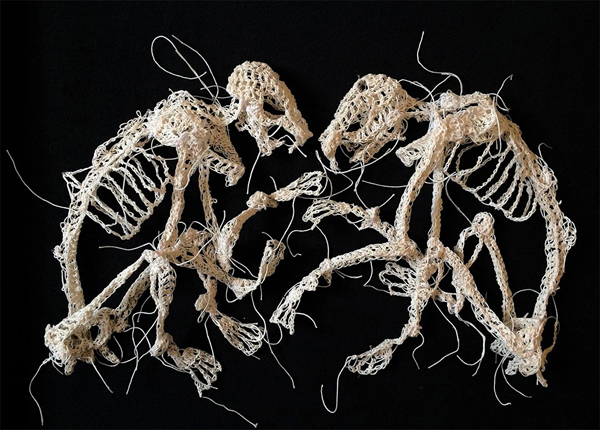
What is your educational background in art?
I received a BFA in Illustration from The University of the Arts in Philadelphia in 2010. I decided to apply to UArts on a whim after learning that the Brothers Quay had attended, never having been to Philadelphia before the day I moved into my dorm.
Did you always make art like this? If not, what did your work used to be like, and how did it grow into this?
In college, my days were spent making three-dimensional illustrations, in which tiny characters would be assembled from Sculpey and whatever else I had lying around. I’d photograph them in environments that I had also built, and would manipulate the images on Photoshop as minimally as possible. After graduating, I encountered the crisis that a lot of art school alum go through, and felt the need to reconsider all of the decisions I had made up to that point in terms of aesthetic proclivities, my career, etc. This, in addition to the sad events that occurred around that time, led me to pursue my current schtick.
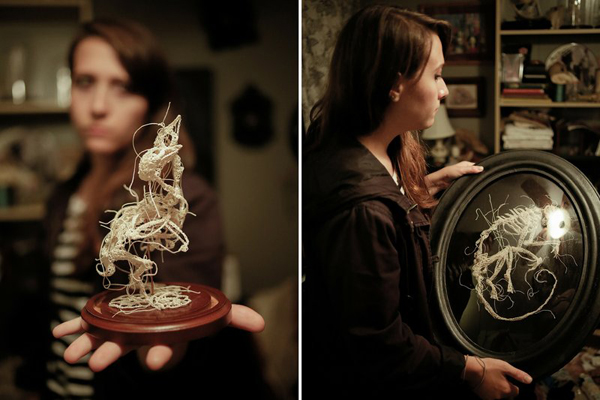
What are you hoping to represent or express in this style?
This series is kind of divided into several phases—initially; my main concern was the continuous circulation of a memory until it has become warped almost beyond recognition. I’m currently creating pieces that involve the implementation of such a misshapen recollection, and how it can overwrite the truth, destroying the authentic account of what actually happened. The works have begun to include relics with undisclosed histories, such as remnants of lace from yard sales, and themes like mutation, glitch-y repetition, and unnatural juxtaposition. I guess I’m trying to explore my own fixation on these themes.
Do you come from a family of creative people? What was childhood like for you?
My parents are both artists. We didn’t have a lot of money when I was growing up, so my mom’s collage supplies sufficed as toys. I spent a lot of time alone in the woods, staring at deer.
Your artist statement talks about family, bonds and ancestry—why is this of interest to you, or rather, why is this important to you?
I think it has a lot to do with the fact that I spent a lot of time alone as a child, and want to preserve the company that I currently have. I’m also very interested in the past, family stories that have been wildly blown out of proportion over the years, and how the way I identify my ancestors might rely entirely on a fabricated foundation of information, which just as well might be true. I love that.

You say your deceased relatives gave you media and practices in your art, and that you “aim to generate emblems of my diminishing bloodline.” What does that mean exactly?
My family is very small. I began creating this type of work during a period in which several people in my life passed away, and felt the need to cling to whatever remnants of their existence I had left in my memory. The image of my grandmother’s doilies unraveling and reconstituting themselves as warped, skeletal creatures kept cycling around in my head. A lot of my work stems from continuous, desperate attempts to keep my family alive, in some way.
Where do you draw your inspiration? Is it always the same?
I kind of just run scans through my memory while I’m sitting alone in the studio or going for a walk at night, and naturally fixate on whatever specific event settles in my brain. I run through it over and over again until it’s unrecognizable. That’s the point where I feel compelled to personify the deformed memory as some sort of beast’s remains. The influences that drive me to engage in this process are always changing, but that moment where I know what I want to make is usually the same.

I am an avid taxidermy lover, and a collector of bones, skulls, and fragments of life in all forms. I think it’s fascinating that you create these relics, these leftover fragments of life, but all from scratch. What is the driving force or interest in making work like this for you?
Death has been an ever-present factor in my life, just as it is for all of us. I lost some friends during my formative years. The body of work I’m currently developing came out of a similar period of grieving, so skeletal forms naturally stemmed from my loops within loops. The view outside of my bedroom window at the time was of a bunch of dilapidated warehouses, which I think engendered an interest in creating objects that were equal parts something and nothing, static yet constantly unraveling or breaking down. I learned that the texture of small cotton fragments stiffened with glue felt almost like a brittle fish bone, and I noticed that the lace-like appearance of the crocheted material resembled microscopic images of bone tissue. It sort of felt right.
How do you come up with the creatures you create? Are they real, studied from life, or fictitious creatures you imagine?
I always begin by sketching a skeleton from memory after visiting a museum or perusing images that I’ve collected. My objective is to deviate from an accurate representation of the form and to let my visual biases take the wheel. Many of my pieces involve animals that are indigenous to the East Coast, where I’m from – squirrels, deer, foxes, finches, and a variety of domestic animals. My memories tend to attach themselves to specific animals that were present during an incident, such as the ferret that was at the birthday party when this happened, or the squirrel that ran across a telephone line when that happened. I grew up in the woods, so animals have always been very important to me and often carry a totemic significance. Sometimes the forms take a grotesque turn and require additional heads or limbs, when the mood strikes.
What artists have inspired your work over the years?
The way Francis Bacon would base his paintings off of assemblages of imagery that he had carefully collated really left its mark on me, after I saw a retrospective of his work with my parents at the Metropolitan Museum of Art. I love the works of Hyman Bloom, Odlion Redon, and Leonard Baskin. Lots of stuff. Allison Sommers is perpetually astounding. I don’t know what I would do without Ingmar Bergman, Andrei Tarkovsky, and Sergei Parajanov. I definitely think about John Carpenter’s The Thing several times over the course of a day. That film might have impacted me more profoundly than anything else.
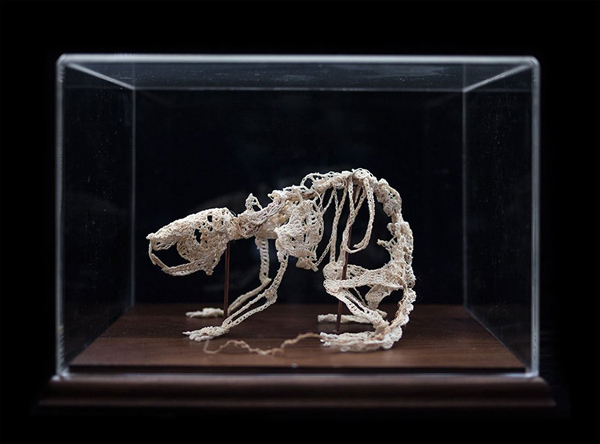
Tell me a little bit about what a normal day looks like for you.
I’ll be honest with you: The first few minutes of the day involves me laying in bed for longer than I’d care to admit, biting my cuticles as I think about the future. Then I go downstairs, consume an entire French press of coffee, talk to my cats, and head back upstairs with every intention of taking a shower, except that usually involves me sitting on my studio floor in my pajamas and getting sucked into a couple hours of work. When my hygiene is finally tended to, I like to walk around the city for a few hours, so my muscles don’t atrophy and so I can continue to be a real human person. Additional coffee is often consumed, at a place around the corner, near where I live in South Philly. I’ll return to work after that, cram some food into my mouth at some point, and continue working into the night.
Can you tell me a little about the work that will be on view in the “Aestheticism” show in Tokyo?
The two pieces that I’m submitting are supposed to kind of sum up the different types of work I’m invested in at the moment, on a small scale. The Web in Her Nest has a remnant of antique lace incorporated into it, with which two bird-creatures are interacting. The other piece, Laqueum, demonstrates my interest in oddly shaped frames that once contained unusual things.
